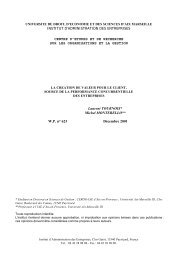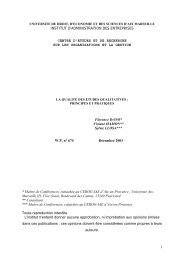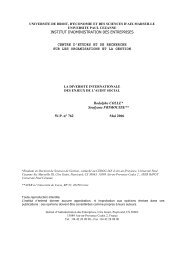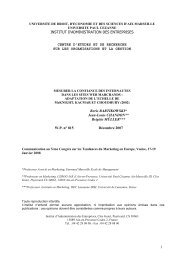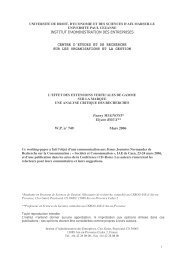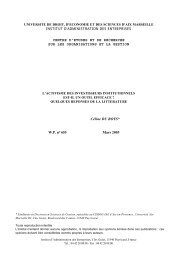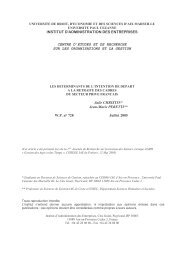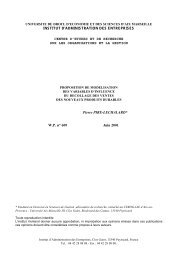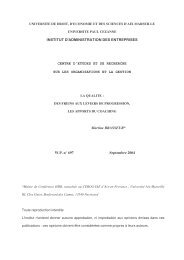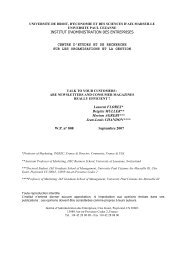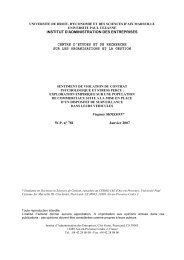Effet book-to-market et mesure de performance à la Bourse ... - cergam
Effet book-to-market et mesure de performance à la Bourse ... - cergam
Effet book-to-market et mesure de performance à la Bourse ... - cergam
You also want an ePaper? Increase the reach of your titles
YUMPU automatically turns print PDFs into web optimized ePapers that Google loves.
UNIVERSITE DE DROIT, D'ECONOMIE ET DES SCIENCES D'AIX MARSEILLEINSTITUT D'ADMINISTRATION DES ENTREPRISESCENTRE D’ETUDES ET DE RECHERCHESUR LES ORGANISATIONS ET LA GESTIONETUDES ET DOCUMENTSSérie "Recherche"EFFET BOOK-TO-MARKETET MESURE DE PERFORMANCEA LA BOURSE DE PARISEric MOLAY*W.P. n°563 Janvier 2000* Etudiant en Doc<strong>to</strong>rat <strong>de</strong> Sciences <strong>de</strong> Gestion, IAE-CEROG, Institut d’Administration <strong>de</strong>s Entreprises d’Aix-en-Provence, Université d’Aix-Marseille III, Clos Guiot, Boulevard <strong>de</strong>s Camus, 13540 PuyricardToute reproduction interditeL'institut n'entend donner aucune approbation, ni improbation aux opinions émises dans ces publications : cesopinions doivent être considérées comme propres à leurs auteurs.Institut d’Administration <strong>de</strong>s Entreprises, Clos Guiot, 13540 Puyricard, FranceTel. : +33 (0)4 42 28 08 08.- Fax : +33 (04 42 28 08 00.
<strong>Eff<strong>et</strong></strong> <strong>book</strong>-<strong>to</strong>-<strong>mark<strong>et</strong></strong> <strong>et</strong> <strong>mesure</strong> <strong>de</strong> <strong>performance</strong>à <strong>la</strong> <strong>Bourse</strong> <strong>de</strong> ParisRESUMELa récente confirmation du rôle joué par le ratio valeur comptable/valeur <strong>de</strong> marché (VC/VM)dans l'explication <strong>de</strong> <strong>la</strong> rentabilité sur différents marchés pose <strong>la</strong> question <strong>de</strong> <strong>la</strong> compréhensiond'une telle re<strong>la</strong>tion. Parallèlement, <strong>la</strong> finance d'entreprise a développé diverses <strong>mesure</strong>s <strong>de</strong> <strong>la</strong><strong>performance</strong> <strong>de</strong>s firmes issues <strong>de</strong> <strong>la</strong> pratique <strong>et</strong> <strong>de</strong> <strong>la</strong> recherche financières. Dans un modèlefac<strong>to</strong>riel <strong>de</strong> rentabilité, trois <strong>mesure</strong>s <strong>de</strong> <strong>la</strong> <strong>performance</strong> (ratio Q <strong>de</strong> Tobin, ratio <strong>de</strong> Sharpe <strong>et</strong>"valeur <strong>de</strong> marché ajoutée") sont substituées au ratio VC/VM. Les re<strong>la</strong>tions attendues entre ces<strong>mesure</strong>s <strong>de</strong> <strong>la</strong> <strong>performance</strong> <strong>et</strong> le ratio VC/VM sont globalement vérifiées. Ainsi, le ratio VC/VMpeut être interpréter comme une <strong>mesure</strong> <strong>de</strong> <strong>la</strong> non-<strong>performance</strong> <strong>de</strong>s entreprises.Mots-clefs : modèle fac<strong>to</strong>riel, MVA, <strong>performance</strong>, ratio VC/VM, ratio Q, ratio <strong>de</strong> Sharpe.ABSTRACTThe recent confirmation of the role <strong>de</strong>voted by the <strong>book</strong>-<strong>to</strong>-<strong>mark<strong>et</strong></strong> ratio in the exp<strong>la</strong>nation ofs<strong>to</strong>ck r<strong>et</strong>urns on international <strong>mark<strong>et</strong></strong>s raises the question of the comprehension of such a re<strong>la</strong>tion.The corporate finance <strong>de</strong>veloped measure of the <strong>performance</strong> of the firms resulting fromfinancial practice and research. In a fac<strong>to</strong>r mo<strong>de</strong>l of s<strong>to</strong>ck, three measures of the <strong>performance</strong>(ratio Q of Tobin, ratio of Sharpe and " value of <strong>mark<strong>et</strong></strong> ad<strong>de</strong>d") are substituted for <strong>book</strong>-<strong>to</strong><strong>mark<strong>et</strong></strong>ratio. The expected re<strong>la</strong>tions b<strong>et</strong>ween these measures of the <strong>performance</strong> and <strong>book</strong>-<strong>to</strong><strong>mark<strong>et</strong></strong>ratio are confirmed overall. Thus, <strong>book</strong>-<strong>to</strong>-<strong>mark<strong>et</strong></strong> ratio can be interpr<strong>et</strong>ed as a measureof the not-<strong>performance</strong> of the firms.Keywords: fac<strong>to</strong>r mo<strong>de</strong>l, <strong>book</strong>-<strong>to</strong>-<strong>mark<strong>et</strong></strong> ratio, MVA, Sharpe ratio, Tobin's Q ratio, firm <strong>performance</strong>.JEL Co<strong>de</strong> : G12 Ass<strong>et</strong> Pricing2
<strong>Eff<strong>et</strong></strong> <strong>book</strong>-<strong>to</strong>-<strong>mark<strong>et</strong></strong> <strong>et</strong> <strong>mesure</strong> <strong>de</strong> <strong>performance</strong> à <strong>la</strong> <strong>Bourse</strong> <strong>de</strong> ParisSommaireINTRODUCTION.................................................................................................................... 42. LA RENTABILITÉ, LE RATIO VALEUR COMPTABLE/VALEUR DE MARCHÉ ETLES MESURES DE PERFORMANCE.............................................................................. 52.1. LA RENTABILITÉ DES TITRES ET LE RATIO VALEUR COMPTABLE/VALEUR DE MARCHÉ ......... 52.2. LA RELATION ENTRE LE RATIO VALEUR COMPTABLE/VALEUR DE MARCHÉ ET LES MESURESDE LA PERFORMANCE....................................................................................................... 62.2.1.Ratio Q <strong>de</strong> Tobin <strong>et</strong> ratio valeur comptable/valeur <strong>de</strong> marché................................ 62.2.2.Ratio <strong>de</strong> Sharpe <strong>et</strong> ratio valeur comptable/valeur <strong>de</strong> marché ................................. 72.2.3."Valeur <strong>de</strong> marché ajoutée" <strong>et</strong> ratio valeur comptable/valeur <strong>de</strong> marché ............... 83. DONNÉES FINANCIÈRES, DONNÉES COMPTABLES ET CONSTRUCTION DESVARIABLES........................................................................................................................ 93.1. LES DONNÉES FINANCIÈRES.............................................................................................. 93.2. LES DONNÉES COMPTABLES.............................................................................................. 93.3. LES VARIABLES EXPLICATIVES ......................................................................................... 93.3.1.La variable explicative <strong>de</strong> marché : R M - R f ............................................................ 93.3.2.Les variables explicatives "fondamentales".......................................................... 103.4. LES VARIABLES EXPLIQUÉES .......................................................................................... 114. RÉSULTATS DES RÉGRESSIONS MULTIPLES......................................................... 124.1. DONNÉES STATISTIQUES................................................................................................. 124.2. LE MODÈLE FACTORIEL DE FAMA ET FRENCH (1993) ...................................................... 124.3. RÉGRESSIONS ASSOCIANT LE FACTEUR DE MARCHÉ, LA TAILLE ET UN INDICE DEPERFORMANCE............................................................................................................... 134.3.1.L'association du facteur <strong>de</strong> marché, <strong>de</strong> <strong>la</strong> taille <strong>et</strong> du ratio Q............................... 144.3.2.L'association du facteur <strong>de</strong> marché, <strong>de</strong> <strong>la</strong> taille <strong>et</strong> du ratio <strong>de</strong> Sharpe .................. 154.3.3.L'association du facteur <strong>de</strong> marché, <strong>de</strong> <strong>la</strong> taille <strong>et</strong> <strong>de</strong> <strong>la</strong> MVA re<strong>la</strong>tive.................. 164.4. MODÈLES DE RENTABILITÉ À UN, DEUX OU TROIS FACTEURS ........................................... 17CONCLUSION....................................................................................................................... 20BIBLIOGRAPHIE ................................................................................................................. 213
<strong>Eff<strong>et</strong></strong> <strong>book</strong>-<strong>to</strong>-<strong>mark<strong>et</strong></strong> <strong>et</strong> <strong>mesure</strong> <strong>de</strong> <strong>performance</strong> à <strong>la</strong> <strong>Bourse</strong> <strong>de</strong> Paris2. La rentabilité, le ratio valeur comptable/valeur <strong>de</strong> marché <strong>et</strong>les <strong>mesure</strong>s <strong>de</strong> <strong>performance</strong>2.1. La rentabilité <strong>de</strong>s titres <strong>et</strong> le ratio valeur comptable/valeur <strong>de</strong> marchéRosenberg, Reid <strong>et</strong> Lanstein (1985) trouvent une re<strong>la</strong>tion positive entre <strong>la</strong> rentabilité <strong>de</strong>s titres <strong>et</strong>le ratio <strong>de</strong> <strong>la</strong> valeur comptable <strong>de</strong>s titres sur leur valeur <strong>de</strong> marché (VC/VM). De même, Chan,Hamao <strong>et</strong> Lakonishok (1991), sur le marché japonais, <strong>et</strong> Fama <strong>et</strong> French (1991), sur le marchéaméricain, i<strong>de</strong>ntifient le ratio valeur comptable/valeur <strong>de</strong> marché (VC/VM) comme facteur explicatif<strong>de</strong>s rentabilités, les entreprises dont le ratio VC/VM est élevé sont associées à <strong>de</strong>srentabilités espérées élevées. Parallèlement, ils montrent que le ratio VC/VM <strong>de</strong>s titres japonaisou américains est une variable explicative plus significative que <strong>la</strong> taille.Fama <strong>et</strong> French (1995) démontrent que le taux <strong>de</strong> rentabilité <strong>de</strong>s actifs d'une firme est en re<strong>la</strong>tionnégative avec le ratio VC/VM : les firmes avec un ratio VC/VM élevé (faible) enregistrent <strong>de</strong>sbénéfices faibles (élevés). Le ratio VC/VM traduit une certaine détresse ou vulnérabilité économique<strong>de</strong>s firmes.Selon Davis, Fama <strong>et</strong> French (1999), quatre types d'argument peuvent expliquer l'anomalieVC/VM observée. Tout d'abord, <strong>la</strong> re<strong>la</strong>tion positive observée entre ratio VC/VM <strong>et</strong> rentabilitémoyenne est spécifique à l'échantillon étudié <strong>et</strong> peut ne pas être démontrée sur d'autres marchésou d'autres pério<strong>de</strong>s (B<strong>la</strong>ck (1993), MacKin<strong>la</strong>y (1995)). Toutefois, Chan, Hamao <strong>et</strong> Lakonishok(1991), Capaul, Rowley <strong>et</strong> Sharpe (1993) ou Fama <strong>et</strong> French (1998) 3 m<strong>et</strong>tent en évi<strong>de</strong>nce uneff<strong>et</strong> ratio VC/VM sur d'autres marchés financiers.Un <strong>de</strong>uxième type d'interprétation indique que l'eff<strong>et</strong> VC/VM ne constitue pas une anomalie <strong>de</strong>rentabilité. La rentabilité plus élevée observée pour les titres <strong>de</strong> ratio VC/VM élevé est liée à uneprime <strong>de</strong> risque reposant sur le modèle d'évaluation par arbitrage (MEA) <strong>de</strong> Ross (1976) ou leMédaf intertemporel <strong>de</strong> Mer<strong>to</strong>n (1973). Pour Fama en French (1993), il existe une covariation<strong>de</strong>s rentabilités liée au ratio VC/VM qui complète celle expliquée par le facteur <strong>de</strong> marché. Fama<strong>et</strong> French (1995) montrent l'influence du facteur VC/VM sur <strong>de</strong>s données fondamentales tellesque les bénéfices <strong>et</strong> le chiffre d'affaires.En troisième lieu, un eff<strong>et</strong> ratio VC/VM serait du à <strong>la</strong> surréaction <strong>de</strong>s investisseurs à <strong>la</strong> <strong>performance</strong><strong>de</strong> l'entreprise. Les titres <strong>de</strong> ratio VC/VM élevé semblent correspondre à <strong>de</strong>s entreprisesdont les fondamentaux comme les bénéfices <strong>et</strong> le chiffre d'affaires sont peu performants. Lesinvestisseurs réagissent excessivement <strong>et</strong> <strong>de</strong> manière irrationnelle à <strong>la</strong> <strong>performance</strong> <strong>de</strong> <strong>la</strong> firme :ils surévaluent les firmes à fort potentiel <strong>et</strong> sous-évaluent les firmes à faible potentiel. Lakonishok,Shleifer <strong>et</strong> Vishny (1994) suggèrent que les rentabilités élevées observées pour les titresavec un ratio VC/VM élevé ("valeurs d'actifs" 4 ) sont le résultat d'erreur d'extrapo<strong>la</strong>tion du taux<strong>de</strong> croissance <strong>de</strong>s bénéfices <strong>de</strong>s entreprises. Les investisseurs semblent excessivement optimistespour <strong>de</strong>s entreprises qui se sont bien comportées dans le passé. Inversement, ils semblent pessimistesvis-à-vis d'entreprises dont les bénéfices passés ont été médiocres. De plus, les titres à34L'étu<strong>de</strong> porte sur 12 marchés hors Etats-Unis (Japon, Gran<strong>de</strong> Br<strong>et</strong>agne, France, Allemagne, Italie, Pays-Bas,Belgique, Suisse, Suè<strong>de</strong>, Australie, Hong Kong <strong>et</strong> Singapour), sur <strong>la</strong> pério<strong>de</strong> 1974-1994. Les portefeuilles <strong>de</strong> titresà ratio VC/VM élevé ("value s<strong>to</strong>cks") présente une rentabilité annuelle moyenne supérieure <strong>de</strong> 7,68 %comparés aux portefeuilles <strong>de</strong> titres à ratio VC/VM faible ("growth s<strong>to</strong>cks").Value s<strong>to</strong>cks in Lakonishok, Shleifer <strong>et</strong> Vishny (1994).5
<strong>Eff<strong>et</strong></strong> <strong>book</strong>-<strong>to</strong>-<strong>mark<strong>et</strong></strong> <strong>et</strong> <strong>mesure</strong> <strong>de</strong> <strong>performance</strong> à <strong>la</strong> <strong>Bourse</strong> <strong>de</strong> Parisfaible ratio VC/VM ("valeurs <strong>de</strong> croissance" 5 ) sont plus recherchés que les valeurs d'actifs parles investisseurs, ce qui entraîne une appréciation <strong>de</strong> leurs cours <strong>et</strong> donc une baisse <strong>de</strong> leur rentabilité.Le quatrième axe d'explication repose sur les caractéristiques fondamentales <strong>de</strong>s entreprises : <strong>la</strong>rentabilité supérieure associée au ratio VC/VM serait liée à ces caractéristiques fondamentales<strong>de</strong>s entreprises <strong>et</strong> non à <strong>de</strong>s facteurs <strong>de</strong> risque (Daniel <strong>et</strong> Titman (1997)). Dans une approchecomportementale, les investisseurs préfèrent généralement les valeurs <strong>de</strong> croissance aux valeursd'actifs. C<strong>et</strong>te simple préférence entraîne une prime liée à <strong>la</strong> valeur <strong>de</strong> l'entreprise (<strong>de</strong>s cours bas<strong>et</strong> <strong>de</strong>s rentabilités espérées plus élevées pour les valeurs d'actifs) qui n'est pas due au risque.Berk (1996) reprenant les arguments développés dans un précé<strong>de</strong>nt article (Berk (1995)) montrequ'une re<strong>la</strong>tion inverse entre rentabilité <strong>et</strong> ratio VC/VM doit être observée. Dans ce cadre, <strong>la</strong>mise en évi<strong>de</strong>nce d'un eff<strong>et</strong> VC/VM (ou taille) ne doit pas être interprété comme une anomalie<strong>de</strong> rentabilité. La valeur comptable <strong>de</strong> <strong>la</strong> firme <strong>mesure</strong> <strong>la</strong> valeur n<strong>et</strong>te <strong>de</strong>s investissements passés.En supposant une forte corré<strong>la</strong>tion entre le montant <strong>de</strong>s investissements <strong>et</strong> les flux espérés <strong>de</strong> cesinvestissements, on doit s'attendre à une forte corré<strong>la</strong>tion entre <strong>la</strong> valeur comptable <strong>de</strong> <strong>la</strong> firme <strong>et</strong>les flux espérés <strong>de</strong>s investissements. La valeur comptable constitue donc un substitut aux fluxespérés. Ainsi, le ratio VC/VM est substitué à un ratio flux espérés/valeur <strong>de</strong> marché <strong>et</strong> <strong>de</strong>vientune meilleure <strong>mesure</strong> <strong>de</strong> <strong>la</strong> rentabilité espérée que <strong>la</strong> seule valeur <strong>de</strong> marché <strong>de</strong>s titres.Analytiquement, le ratio VC/VM doit être relié à <strong>la</strong> rentabilité espérée pour une firme donnée àNCFtpartir <strong>de</strong> <strong>la</strong> re<strong>la</strong>tion inverse entre rentabilité attendue <strong>et</strong> valeur <strong>de</strong> marché : VM = ∑tt= 1 [1+E(r) ](Batteau <strong>et</strong> Lasgouttes (1997)). La division par <strong>la</strong> constante VC ne change pas les re<strong>la</strong>tions précé<strong>de</strong>ntes: = ∑6 . On doit donc observer une re<strong>la</strong>tion inverse entre <strong>la</strong> rentabilitéNVM CF t/VCtVC t= 1 [1+E(r) ]espérée <strong>et</strong> le ratio VM/VC. Inversement, une re<strong>la</strong>tion positive doit être observée entre le ratioinverse VC/VM <strong>et</strong> <strong>la</strong> rentabilité <strong>de</strong>s titres : les titres présentant un ratio VC/VM élevé (faible)doivent présenter une rentabilité plus élevée (faible) que les titres présentant un ratio VC/VMfaible (élevé).2.2. La re<strong>la</strong>tion entre le ratio valeur comptable/valeur <strong>de</strong> marché <strong>et</strong> les <strong>mesure</strong>s <strong>de</strong> <strong>la</strong> <strong>performance</strong>2.2.1. Ratio Q <strong>de</strong> Tobin <strong>et</strong> ratio valeur comptable/valeur <strong>de</strong> marchéLe ratio Q <strong>de</strong> Tobin constitue une <strong>mesure</strong> généralement acceptée <strong>de</strong> <strong>la</strong> <strong>performance</strong> <strong>de</strong> <strong>la</strong> firme.Ce ratio, défini comme <strong>la</strong> valeur <strong>de</strong> marché <strong>de</strong> l'entreprise sur le coût <strong>de</strong> remp<strong>la</strong>cement <strong>de</strong> cesactifs, est souvent employé pour tester <strong>la</strong> <strong>performance</strong> <strong>de</strong>s entreprises dans diverses re<strong>la</strong>tions enfinance d'entreprise.Alors que le ratio <strong>de</strong> Marris correspond à l'inverse du ratio VC/VM <strong>et</strong> ne r<strong>et</strong>ient que les capitauxinvestis par les actionnaires, le ratio Q théorique <strong>de</strong> Tobin intègre <strong>la</strong> valeur <strong>de</strong> marché <strong>de</strong>s d<strong>et</strong>tes56Growth s<strong>to</strong>cks in Lakonishok, Shleifer <strong>et</strong> Vishny (1994).Avec VM : valeur <strong>de</strong> marché, VC : valeur comptable, CF t : flux versés aux actionnaires aux dates t = (1,2,…,N)<strong>et</strong> E(r) t : taux <strong>de</strong> rentabilité espéré ajusté pour le risque.6
<strong>Eff<strong>et</strong></strong> <strong>book</strong>-<strong>to</strong>-<strong>mark<strong>et</strong></strong> <strong>et</strong> <strong>mesure</strong> <strong>de</strong> <strong>performance</strong> à <strong>la</strong> <strong>Bourse</strong> <strong>de</strong> ParisCPVM+ DVMfinancières. Formellement, le Q <strong>de</strong> Tobin s'exprime par le ratio : Q = , où CP VM estA VM<strong>la</strong> valeur <strong>de</strong> marché <strong>de</strong>s capitaux propres, D VM celle <strong>de</strong>s d<strong>et</strong>tes financières <strong>et</strong> A VM le coût <strong>de</strong>remp<strong>la</strong>cement <strong>de</strong>s actifs. La difficulté d'évaluation <strong>de</strong> certaines <strong>de</strong>s variables conduit à r<strong>et</strong>enirVM + DVCl'approximation développée par Chung <strong>et</strong> Pruitt (1994) : QCP= , où VM est <strong>la</strong> capitalisationboursière <strong>de</strong> l'entreprise 7 , D VC correspond à <strong>la</strong> valeur comptable <strong>de</strong>s d<strong>et</strong>tes à long termeATVC<strong>et</strong> court terme diminuée <strong>de</strong>s actifs à court terme (D VC = D LT + D CT - A CT ) <strong>et</strong> AT VC est <strong>la</strong> valeurcomptable <strong>de</strong> l'actif <strong>to</strong>tal. Malgré les biais introduits par rapport au modèle théorique, les résultatssont compatibles avec d'autres formu<strong>la</strong>tions 8 <strong>et</strong> c<strong>et</strong>te approximation requiert <strong>de</strong>s donnéesfinancières <strong>et</strong> comptables aisément disponibles.La re<strong>la</strong>tion entre le ratio VC/VM <strong>et</strong> le ratio <strong>de</strong> Marris est évi<strong>de</strong>nte, le ratio <strong>de</strong> Marris est l'inversedu ratio VC/VM. La différence entre le Q CP <strong>et</strong> le ratio VC/VM tel qu'il est défini par DatastreamInternational rési<strong>de</strong> essentiellement dans <strong>la</strong> valeur comptable <strong>de</strong>s actifs incorporels <strong>et</strong> <strong>de</strong>s actifs àcourt terme.La formu<strong>la</strong>tion du ratio VC/VM issue <strong>de</strong> Datastream International s'établit comme suit :VC CPVC − INCVC=VM VM , où CPVC est <strong>la</strong> valeur comptable <strong>de</strong>s capitaux propres, INCVC <strong>la</strong> valeurcomptable <strong>de</strong>s actifs incorporels. La valeur comptable correspond à l'actif corporel n<strong>et</strong>VC = CPVC - INVVC. A partir <strong>de</strong> l'égalité suivante ATVC = VC + INCVC + DVC + ACT, ilest possible <strong>de</strong> remp<strong>la</strong>cer ATVC dans le calcul du ratio Q <strong>de</strong> Chung <strong>et</strong> Pruit (1994),VM + DVCVM + DVCQCP=QCP=VC + INCVC+ DVC+ A CT , soitCPVC+ DLT+ DCT . La différence entre le ratioVC/VM <strong>et</strong> ratio Q tient à l'inversion du rapport <strong>et</strong> à <strong>la</strong> valeur comptable <strong>de</strong>s d<strong>et</strong>tes <strong>et</strong> <strong>de</strong>s actifsincorporelsUne re<strong>la</strong>tion inverse entre le ratio VC/VM <strong>et</strong> le ratio Q CP doit être observée. La rentabilité <strong>de</strong>stitres, liée positivement au ratio VC/VM, doit être liée négativement au ratio Q CP tel que formulépar Chung <strong>et</strong> Pruitt (1994).2.2.2. Ratio <strong>de</strong> Sharpe <strong>et</strong> ratio valeur comptable/valeur <strong>de</strong> marchéRLe ratio <strong>de</strong> Sharpe <strong>mesure</strong> <strong>la</strong> rémunération offerte par unité <strong>de</strong> risque : i − RS = f, où R i - R fσ ireprésente l'excès <strong>de</strong> rentabilité d'un titre (R i ) par rapport au taux sans risque (R f ) <strong>et</strong> l'écart type<strong>de</strong>s rentabilités (σ i ) <strong>mesure</strong> le risque. Parallèlement, le ratio VC/VM est lié positivement à <strong>la</strong>rentabilité espérée d'une firme donnée 9 . En r<strong>et</strong>enant l'hypothèse d'un niveau <strong>de</strong> risque constantsur une pério<strong>de</strong>, le ratio <strong>de</strong> Sharpe doit être en re<strong>la</strong>tion positive avec le ratio VC/VM <strong>et</strong> donc <strong>la</strong>rentabilité <strong>de</strong>s titres.789C<strong>et</strong>te valeur <strong>de</strong> marché intègre <strong>la</strong> valeur boursière <strong>de</strong>s actions ordinaires <strong>et</strong> <strong>la</strong> valeur <strong>de</strong> liquidation <strong>de</strong>s actions àdivi<strong>de</strong>n<strong>de</strong>s prioritaires (actions privilégiées).En comparant leur formu<strong>la</strong>tion avec celle <strong>de</strong> Lin<strong>de</strong>nberg <strong>et</strong> Ross (1981), Chang <strong>et</strong> Pruit (1994) montrent unecorré<strong>la</strong>tion entre les <strong>de</strong>ux formu<strong>la</strong>tions <strong>de</strong> 96,6 %.Voir notamment Batteau <strong>et</strong> Lasgouttes (1997) <strong>et</strong> Mo<strong>la</strong>y (2000).7
<strong>Eff<strong>et</strong></strong> <strong>book</strong>-<strong>to</strong>-<strong>mark<strong>et</strong></strong> <strong>et</strong> <strong>mesure</strong> <strong>de</strong> <strong>performance</strong> à <strong>la</strong> <strong>Bourse</strong> <strong>de</strong> Paris2.2.3. "Valeur <strong>de</strong> marché ajoutée" <strong>et</strong> ratio valeur comptable/valeur <strong>de</strong> marchéLa "valeur ajoutée <strong>de</strong> marché" représente <strong>la</strong> différence entre <strong>la</strong> valeur <strong>de</strong> marché <strong>de</strong>s capitauxinvestis (VM) <strong>et</strong> <strong>la</strong> valeur comptable <strong>de</strong> ces mêmes capitaux (VC), MVA = VM - VC. A l'inversedu ratio Q <strong>de</strong> Tobin, il s'agit d'une <strong>mesure</strong> absolue <strong>de</strong> <strong>la</strong> création <strong>de</strong> valeur pourl'actionnaire. En ne r<strong>et</strong>enant que les capitaux investis par les actionnaires, on démontre que leratio VC/VM <strong>et</strong> <strong>la</strong> MVA sont logiquement liés. Une <strong>mesure</strong> <strong>de</strong> <strong>la</strong> MVA re<strong>la</strong>tive à <strong>la</strong> valeur <strong>de</strong>MVAmarché (MVA R ) peut être calculée : MVA R = . Le ratio VC/VM <strong>et</strong> <strong>la</strong> MVA R sont liés parVMVM - VC VCl'égalité suivante : MVA R = = 1−. Une re<strong>la</strong>tion négative doit être observée entreVM VMMVA R <strong>et</strong> le ratio VC/VM, <strong>et</strong> donc entre MVA R <strong>et</strong> rentabilité <strong>de</strong>s titres.8
<strong>Eff<strong>et</strong></strong> <strong>book</strong>-<strong>to</strong>-<strong>mark<strong>et</strong></strong> <strong>et</strong> <strong>mesure</strong> <strong>de</strong> <strong>performance</strong> à <strong>la</strong> <strong>Bourse</strong> <strong>de</strong> Paris3. Données financières, données comptables <strong>et</strong> construction <strong>de</strong>s variablesLa méthodologie <strong>de</strong> c<strong>et</strong>te étu<strong>de</strong> est adaptée <strong>de</strong> Fama <strong>et</strong> French (1993). Elle repose sur <strong>la</strong> construction<strong>de</strong> portefeuilles <strong>de</strong> titres d'arbitrage, tant pour les variables expliquées que pour lesvariables explicatives fondamentales <strong>et</strong> <strong>de</strong> marché (R M - R f ). Les données financières <strong>et</strong> comptablessont extraites <strong>de</strong> <strong>la</strong> base <strong>de</strong> données Datastream International. L'échantillon comprend lestitres pour lesquels les données financières (cours <strong>et</strong> divi<strong>de</strong>n<strong>de</strong>s) <strong>et</strong> comptables sont disponiblesdans <strong>la</strong> base <strong>de</strong> données 10 .3.1. Les données financièresL'his<strong>to</strong>rique <strong>de</strong>s cours s'étend d'avril 1987 à mars 1997, soit 120 mois. Les cours <strong>et</strong> divi<strong>de</strong>n<strong>de</strong>s 11fournis par Datastream International sont ajustées <strong>de</strong>s modifications <strong>de</strong> capital. La rentabilité <strong>de</strong>s~PitPi(t1) Di(t1; t)titres individuels est calculée par R ~ − − + −i(t− 1; t) = . La rentabilité <strong>de</strong>s portefeuillesPi(t− 1)N1correspond à R ~ p (t − 1; t) =−∑ R ~i(t1; t) .Ni = 1Le p<strong>la</strong>cement à taux sans risque, R f , est le taux moyen mensuel du marché monétaire (T4M),disponible dans <strong>la</strong> base <strong>de</strong> données Datastream International. Le taux sans risque r<strong>et</strong>enu dans lestests correspond au taux mensuel équivalent 12 . Le portefeuille <strong>de</strong> référence, portefeuille <strong>de</strong> marché,est constitué <strong>de</strong> l’ensemble <strong>de</strong>s titres <strong>de</strong> l’échantillon.3.2. Les données comptablesLes données comptables <strong>de</strong> chaque fin d'année fiscale (décembre t-1) sont r<strong>et</strong>enues pour c<strong>la</strong>sserles titres. La valeur comptable correspond à l'actif corporel n<strong>et</strong> en décembre t-1. La valeur <strong>de</strong>marché est <strong>la</strong> capitalisation boursière en décembre t-1. La valeur comptable <strong>de</strong> l'actif <strong>to</strong>tal, <strong>de</strong>sd<strong>et</strong>tes (long <strong>et</strong> court terme) <strong>et</strong> <strong>de</strong>s actifs (incorporels <strong>et</strong> à court terme) est évaluée <strong>de</strong> même endécembre t-1.3.3. Les variables explicativesLa construction <strong>de</strong>s portefeuilles est différente <strong>de</strong> celle utilisée par Fama <strong>et</strong> French (1993) 13 <strong>et</strong>reprend <strong>la</strong> méthodologie r<strong>et</strong>enue par Liew <strong>et</strong> Vassalou (1999) 14 . Un c<strong>la</strong>ssement successif <strong>de</strong>stitres est effectué suivant leur capitalisation boursière <strong>et</strong> leur ratio VC/VM puis les portefeuillessont construits en r<strong>et</strong>enant pour chaque portefeuille l'ensemble <strong>de</strong>s titres issus <strong>de</strong> c<strong>et</strong>te répartitionséquentielle.3.3.1. La variable explicative <strong>de</strong> marché : R M - R fLa variable R M correspond à <strong>la</strong> rentabilité du marché représenté par l'ensemble <strong>de</strong>s titres <strong>de</strong>10 La base <strong>de</strong> données ainsi constituée correspond à 85 % <strong>de</strong> <strong>la</strong> capitalisation boursière du marché français (sourceDatastream International).11 Les divi<strong>de</strong>n<strong>de</strong>s versés sont inclus dans le calcul <strong>de</strong> <strong>la</strong> rentabilité <strong>de</strong>s portefeuilles dans le mois <strong>de</strong> leur apparition.12 Soit Rf = (1 + T4M) 1/12 - 1.13 Fama <strong>et</strong> French (1993) répartissent les titres <strong>de</strong> manière indépendante suivant leur taille <strong>et</strong> leur ratio VC/VM.14 C<strong>et</strong>te métho<strong>de</strong> <strong>de</strong> construction est utilisée en raison du nombre re<strong>la</strong>tivement faible <strong>de</strong> titres dans les premièresannées <strong>de</strong> l'échantillon. Il perm<strong>et</strong> <strong>de</strong> construire 9 portefeuilles composés du même nombre <strong>de</strong> titres. L'ordre <strong>de</strong>répartition a été inversé pour vérifier que l'ordre r<strong>et</strong>enu n'influençait pas les résultats obtenus.9
<strong>Eff<strong>et</strong></strong> <strong>book</strong>-<strong>to</strong>-<strong>mark<strong>et</strong></strong> <strong>et</strong> <strong>mesure</strong> <strong>de</strong> <strong>performance</strong> à <strong>la</strong> <strong>Bourse</strong> <strong>de</strong> Paris3.4. Les variables expliquéesLa construction <strong>de</strong> portefeuilles homogènes par rapport à un critère (taille, ratio Q, ratio <strong>de</strong>Sharpe ou MVA) perm<strong>et</strong> <strong>de</strong> réduire, par diversification, l'impact d'autres facteurs spécifiques 18 .Les portefeuilles dont <strong>la</strong> rentabilité doit être expliquée sont construits en reprenant <strong>la</strong> méthodologieprécé<strong>de</strong>nte. Neuf portefeuilles sont construits à l'intersection <strong>de</strong>s <strong>de</strong>ux répartitions. Larentabilité en excès du taux sans risque <strong>de</strong> ces neuf portefeuilles représente les variables dépendantes<strong>de</strong>s régressions chronologiques.18 Voir notamment Fama <strong>et</strong> French (1993) <strong>et</strong> Lakonishok, Shleifer <strong>et</strong> Vishny (1994).11
<strong>Eff<strong>et</strong></strong> <strong>book</strong>-<strong>to</strong>-<strong>mark<strong>et</strong></strong> <strong>et</strong> <strong>mesure</strong> <strong>de</strong> <strong>performance</strong> à <strong>la</strong> <strong>Bourse</strong> <strong>de</strong> Paris4. Résultats <strong>de</strong>s régressions multiples4.1. Données statistiquesLes corré<strong>la</strong>tions entre les variables confirment partiellement le sens <strong>de</strong>s re<strong>la</strong>tions entre le ratioVC/VM <strong>et</strong> les <strong>mesure</strong>s <strong>de</strong> <strong>performance</strong>. La re<strong>la</strong>tion entre le ratio VC/VM <strong>et</strong> <strong>de</strong>ux <strong>mesure</strong>s <strong>de</strong><strong>performance</strong> (ratio Q <strong>et</strong> MVA R ) est négative. C<strong>et</strong>te re<strong>la</strong>tion particulièrement forte pour le coupleMVA R /ratioVC/VM est expliquée par <strong>la</strong> définition <strong>de</strong> ces <strong>de</strong>ux <strong>mesure</strong>s. A l'inverse, <strong>la</strong> re<strong>la</strong>tionpositive attendue entre le ratio VC/VM <strong>et</strong> le ratio <strong>de</strong> Sharpe n'est pas observée. Le ratio <strong>de</strong>Sharpe est une <strong>mesure</strong> <strong>de</strong> <strong>la</strong> <strong>performance</strong> liée au marché dont <strong>la</strong> construction ne repose pas sur<strong>de</strong>s données comptables.Tableau I : Corré<strong>la</strong>tion entre les variables explicatives :04/87 à 03/97, 120 moisR M - R f Taille VC/VM Q Sharpe MVA RR M - R f 1.00Taille 0.45 1.00VC/VM 0.29 0.31 1.00Q -0.30 -0.22 -0.27 1.00Sharpe 0.12 0.18 -0.03 0.17 1.00MVA R -0.32 -0.29 -0.93 0.35 0.12 1.00La rentabilité moyenne du portefeuille associé au ratio VC/VM est positive alors que les rentabilitésmensuelles du ratio Q <strong>et</strong> <strong>de</strong> <strong>la</strong> MVA R sont négatives. Les re<strong>la</strong>tions inverses attendues entrele ratio VC/VM d'une part <strong>et</strong> le ratio Q ou <strong>la</strong> MVA R d'autre part sont confirmées. La rentabilitémoyenne <strong>de</strong> l'indice constitué <strong>de</strong>s titres <strong>de</strong> l'échantillon est peu différente <strong>de</strong> celle du portefeuilled'arbitrage lié au ratio VC/VM. Cependant, l'écart type <strong>de</strong>s rentabilités plus faible pour ce <strong>de</strong>rniersuggère qu'il domine le portefeuille <strong>de</strong> marché. Le portefeuille lié à l'eff<strong>et</strong> taille enregistre unerentabilité élevée associée à un écart type important. Le portefeuille d'arbitrage lié au ratio Qapparaît comme le moins risqué. La rentabilité mensuelle moyenne liée au ratio <strong>de</strong> Sharpe est <strong>la</strong>plus faible en valeur absolue.Tableau II : Données statistiques mensuelles moyennes : 04/87 à 03/97, 120 moisR M - R f Taille VC/VM Ratio QRatio <strong>de</strong>SharpeMVA RRentabilité moyenne 0.0032 0.0045 0.0030 - 0.0033 0.0024 -0.0050Ecart type 0.0634 0.0407 0.0285 0.0222 0.0328 0.02864.2. Le modèle fac<strong>to</strong>riel <strong>de</strong> Fama <strong>et</strong> French (1993)Un premier test du modèle <strong>de</strong> Fama <strong>et</strong> French (1993) sur le marché français <strong>de</strong> juin 1992 à juill<strong>et</strong>1997 n'a pas permis <strong>de</strong> m<strong>et</strong>tre en évi<strong>de</strong>nce le rôle du ratio VC/VM dans l'explication <strong>de</strong>s rentabilités19 . Le modèle fac<strong>to</strong>riel est testé sur une pério<strong>de</strong> plus longue (120 mois), un échantillon plus19 Ces résultats peuvent être dus notamment à <strong>de</strong>s erreurs dans les variables comptables reconstruites pour calculerle ratio VC/VM ou à une pério<strong>de</strong> <strong>de</strong> 60 mois sur <strong>la</strong>quelle l'eff<strong>et</strong> lié à <strong>la</strong> vulnérabilité <strong>de</strong>s entreprises n'était pas significatif.12
<strong>Eff<strong>et</strong></strong> <strong>book</strong>-<strong>to</strong>-<strong>mark<strong>et</strong></strong> <strong>et</strong> <strong>mesure</strong> <strong>de</strong> <strong>performance</strong> à <strong>la</strong> <strong>Bourse</strong> <strong>de</strong> Parisimportant. L'his<strong>to</strong>rique du ratio VC/VM est directement issu <strong>de</strong> <strong>la</strong> base <strong>de</strong> données DatastreamInternational.Le modèle d'explication <strong>de</strong>s rentabilités associe le facteur <strong>de</strong> marché, <strong>la</strong> capitalisation boursière<strong>de</strong>s titres <strong>et</strong> le ratio VC/VM. La régression [1] perm<strong>et</strong> <strong>de</strong> tester ce modèle sur l'échantillon. (R M -R f ), TAILLE <strong>et</strong> VC/VM sont les variables indépendantes <strong>et</strong>, b i , t i <strong>et</strong> q i les coefficients <strong>de</strong> <strong>la</strong> régression:R i - R f = α i + β i (R M - R f ) + t i TAILLE + v i VC/VM + ε i [1]Tableau III : Régressions <strong>de</strong> l'excès <strong>de</strong> rentabilité mensuelle non pondérée<strong>de</strong>s 9 portefeuilles c<strong>la</strong>ssés par taille <strong>et</strong> ratio VC/VM : 04/87 à 03/97, 120 moisR i - R f = α i + β i (R M - R f ) + t i TAILLE + v i VC/VM + ε iRatio VC/VM Ratio VC/VMElevé Med Faible Elevé Med FaibleTaille α Taille t(α)Gran<strong>de</strong> -0.002 0.001 0.002 Gran<strong>de</strong> -1.149 0.528 1.218Med -0.001 0.001 -0.002 Med -0.416 0.275 -0.905P<strong>et</strong>ite 0.004 -0.002 0.000 P<strong>et</strong>ite 1.333 -0.843 -0.039βt(β)Gran<strong>de</strong> 0.966 1.009 0.954 Gran<strong>de</strong> 32.824*** 31.477*** 26.372***Med 1.014 1.068 1.042 Med 20.822*** 24.971*** 28.550***P<strong>et</strong>ite 1.035 0.873 1.019 P<strong>et</strong>ite 21.697*** 21.003*** 27.958***Tt(t)Gran<strong>de</strong> -0.538 -0.427 -0.428 Gran<strong>de</strong> -11.668*** -8.500*** -7.555***Med -0.198 0.062 -0.052 Med -2.598** 0.930 -0.910P<strong>et</strong>ite 0.670 0.524 0.414 P<strong>et</strong>ite 8.966*** 8.043*** 7.251***Vt(v)Gran<strong>de</strong> 0.432 -0.100 -0.444 Gran<strong>de</strong> 7.021*** -1.493 -5.875***Med 0.635 -0.060 -0.377 Med 6.235*** -0.676 -4.931***P<strong>et</strong>ite 0.587 -0.175 -0.524 P<strong>et</strong>ite 5.885*** -2.017** -6.873***R² ajusté d.d.l. s(e)Gran<strong>de</strong> 0.915 0.897 0.855 Gran<strong>de</strong> 0.018 0.020 0.022Med 0.840 0.873 0.889 Med 0.030 0.026 0.022P<strong>et</strong>ite 0.903 0.872 0.909 P<strong>et</strong>ite 0.029 0.025 0.022p.c. < 0,10 / ** p.c. < 0,05 / *** p.c. < 0,01L'eff<strong>et</strong> taille est confirmé, <strong>la</strong> variable taille est significative au seuil <strong>de</strong> 0,05 pour sept <strong>de</strong>s neufportefeuilles. Contrairement à une étu<strong>de</strong> précé<strong>de</strong>nte, l'eff<strong>et</strong> lié au ratio VC/VM est observé sur <strong>la</strong>pério<strong>de</strong> <strong>et</strong> l'échantillon étudiés. La re<strong>la</strong>tion est significative au seuil <strong>de</strong> 0,05 pour sept <strong>de</strong>s neufportefeuilles. La constante α n'est en pas significative au seuil <strong>de</strong> 0,10. La variable <strong>de</strong> marché estsignificative au seuil <strong>de</strong> 1 % pour l'ensemble <strong>de</strong>s portefeuilles <strong>et</strong> confirme son rôle essentiel dansl'explication <strong>de</strong>s rentabilités <strong>de</strong>s portefeuilles. Le coefficient <strong>de</strong> détermination moyen ajusté <strong>de</strong>s<strong>de</strong>grés <strong>de</strong> liberté se situe 88,4 %.4.3. Régressions associant le facteur <strong>de</strong> marché, <strong>la</strong> taille <strong>et</strong> un indice <strong>de</strong> <strong>performance</strong>Trois modèles <strong>de</strong> régression sont testés associant le facteur <strong>de</strong> marché, le facteur TAILLE <strong>et</strong>13
<strong>Eff<strong>et</strong></strong> <strong>book</strong>-<strong>to</strong>-<strong>mark<strong>et</strong></strong> <strong>et</strong> <strong>mesure</strong> <strong>de</strong> <strong>performance</strong> à <strong>la</strong> <strong>Bourse</strong> <strong>de</strong> Parisl'une <strong>de</strong>s <strong>mesure</strong>s <strong>de</strong> <strong>performance</strong> définies précé<strong>de</strong>mment : ratio Q <strong>de</strong> Tobin, ratio <strong>de</strong> Sharpe <strong>et</strong>MVA re<strong>la</strong>tive. Le double c<strong>la</strong>ssement par capitalisation boursière <strong>et</strong> facteur <strong>de</strong> <strong>performance</strong> perm<strong>et</strong><strong>de</strong> contrôler l'eff<strong>et</strong> taille.4.3.1. L'association du facteur <strong>de</strong> marché, <strong>de</strong> <strong>la</strong> taille <strong>et</strong> du ratio QCe modèle associe le facteur <strong>de</strong> marché, <strong>la</strong> capitalisation boursière <strong>de</strong>s titres <strong>et</strong> le ratio Q calculéd'après Chung <strong>et</strong> Pruitt (1994). La régression [2] perm<strong>et</strong> <strong>de</strong> tester ce modèle sur l'échantillonr<strong>et</strong>enu. (R M - R f ), TAILLE <strong>et</strong> PERF Q représentent les variables indépendantes <strong>et</strong>, b i , t i <strong>et</strong> q i lescoefficients <strong>de</strong> <strong>la</strong> régression :R i - R f = α i + β i (R M - R f ) + t i TAILLE + q i PERF Q + ε i [2]Le test utilise les neuf portefeuilles <strong>de</strong> titres c<strong>la</strong>ssés par taille <strong>et</strong> ratio Q comme variables dépendantes<strong>et</strong> les <strong>de</strong>ux portefeuilles TAILLE <strong>et</strong> PERF Q associés au facteur <strong>de</strong> marché R M -R f commevariables indépendantes.Tableau IV : Régressions <strong>de</strong> l'excès <strong>de</strong> rentabilité mensuelle non pondérée<strong>de</strong>s 9 portefeuilles c<strong>la</strong>ssés par taille <strong>et</strong> ratio Q : 04/87 à 03/97, 120 moisR i - R f = α i + β i (R M - R f ) + t i TAILLE + q i PERF Q + ε iRatio QRatio QElevé Med Faible Elevé Med FaibleTaille α Taille t(α)Gran<strong>de</strong> -0.001 0.003 0.002 Gran<strong>de</strong> -0.369 1.162 0.782Med 0.003 -0.003 -0.001 Med 1.072 -1.300 -0.351P<strong>et</strong>ite 0.000 0.002 0.001 P<strong>et</strong>ite 0.116 0.658 0.576βt(β)Gran<strong>de</strong> 0.911 1.024 0.982 Gran<strong>de</strong> 25.667*** 24.015*** 29.816***Med 1.067 0.939 0.997 Med 25.465*** 23.415*** 24.925***P<strong>et</strong>ite 0.946 1.025 0.946 P<strong>et</strong>ite 27.558*** 19.765*** 22.576***tt(t)Gran<strong>de</strong> -0.327 -0.482 -0.672 Gran<strong>de</strong> -5.946*** -7.296*** -13.166***Med 0.000 -0.102 -0.078 Med 0.005 -1.642 -1.265P<strong>et</strong>ite 0.228 0.639 0.652 P<strong>et</strong>ite 4.294*** 7.949*** 10.047***qt(q)Gran<strong>de</strong> 0.378 -0.061 -0.429 Gran<strong>de</strong> 3.895*** -0.525 -4.767***Med 0.560 -0.061 -0.458 Med 4.889*** -0.559 -4.192***P<strong>et</strong>ite 0.529 0.005 -0.646 P<strong>et</strong>ite 5.632*** 0.038 -5.646***R² ajusté d.d.l. s(e)Gran<strong>de</strong> 0.849 0.840 0.900 Gran<strong>de</strong> 0.022 0.027 0.021Med 0.858 0.843 0.872 Med 0.027 0.025 0.025P<strong>et</strong>ite 0.888 0.847 0.898 P<strong>et</strong>ite 0.022 0.033 0.027p.c. < 0,10 / ** p.c. < 0,05 / *** p.c. < 0,01Le modèle <strong>de</strong> régression explique en moyenne 86,6 % <strong>de</strong> <strong>la</strong> rentabilité <strong>de</strong>s portefeuilles c<strong>la</strong>sséspar taille <strong>et</strong> ratio Q. La constante α n'est pas différente <strong>de</strong> <strong>la</strong> valeur 0 au seuil <strong>de</strong> 0,10. Le rôleessentiel dans l'explication <strong>de</strong>s rentabilités revient à <strong>la</strong> variable <strong>de</strong> marché (R M -R f ). La re<strong>la</strong>tionentre <strong>la</strong> rentabilité <strong>de</strong>s portefeuilles <strong>et</strong> <strong>la</strong> variable <strong>de</strong> <strong>performance</strong> liée au ratio Q est démontrée14
<strong>Eff<strong>et</strong></strong> <strong>book</strong>-<strong>to</strong>-<strong>mark<strong>et</strong></strong> <strong>et</strong> <strong>mesure</strong> <strong>de</strong> <strong>performance</strong> à <strong>la</strong> <strong>Bourse</strong> <strong>de</strong> Parispour les six portefeuilles extrêmes. La rentabilité moyenne mensuelle du portefeuille PERF Qétant négative, <strong>la</strong> re<strong>la</strong>tion inverse attendue entre <strong>la</strong> rentabilité <strong>de</strong>s portefeuilles <strong>et</strong> <strong>la</strong> <strong>mesure</strong> <strong>de</strong><strong>performance</strong> est observée.4.3.2. L'association du facteur <strong>de</strong> marché, <strong>de</strong> <strong>la</strong> taille <strong>et</strong> du ratio <strong>de</strong> SharpeIci, l'explication <strong>de</strong> <strong>la</strong> rentabilité <strong>de</strong>s portefeuilles repose sur le facteur <strong>de</strong> marché, <strong>la</strong> capitalisationboursière <strong>de</strong>s titres <strong>et</strong> le ratio <strong>de</strong> Sharpe. La régression [3] perm<strong>et</strong> <strong>de</strong> tester ce modèle surl'échantillon. (R M - R f ), TAILLE <strong>et</strong> PERF S représentent les variables indépendantes <strong>et</strong>, b i , t i <strong>et</strong> s iles coefficients <strong>de</strong> <strong>la</strong> régression :R i - R f = α i + β i (R M - R f ) + t i TAILLE + s i PERF S + ε i [3]Le test utilise les neuf portefeuilles <strong>de</strong> titres c<strong>la</strong>ssés par taille <strong>et</strong> ratio <strong>de</strong> Sharpe comme variablesdépendantes <strong>et</strong> les <strong>de</strong>ux portefeuilles TAILLE <strong>et</strong> PERF S associés au facteur <strong>de</strong> marché R M -R fcomme variables indépendantes. Le ratio <strong>de</strong> Sharpe est estimé sur douze mois précédant <strong>la</strong> formation<strong>de</strong>s portefeuilles 20 .Tableau V : Régressions <strong>de</strong> l'excès <strong>de</strong> rentabilité mensuelle non pondérée<strong>de</strong>s 9 portefeuilles c<strong>la</strong>ssés par taille <strong>et</strong> ratio <strong>de</strong> Sharpe : 04/87 à 03/97, 120 moisR i - R f = α i + β i (R M - R f ) + t i TAILLE + s i PERF S + ε iRatio <strong>de</strong> Sharpe Ratio <strong>de</strong> SharpeElevé Med Faible Elevé Med FaibleTaille α Taille t(α)Gran<strong>de</strong> -0.001 0.002 0.002 Gran<strong>de</strong> -0.718 1.084 0.827Med 0.002 -0.003 0.002 Med 0.602 -1.257 0.776P<strong>et</strong>ite 0.003 0.000 -0.001 P<strong>et</strong>ite 1.232 0.171 -0.317βt(β)Gran<strong>de</strong> 0.905 0.938 1.016 Gran<strong>de</strong> 31.368*** 35.476*** 29.274***Med 0.976 0.898 0.908 Med 22.854*** 20.663*** 22.247***P<strong>et</strong>ite 1.012 0.876 0.970 P<strong>et</strong>ite 29.139*** 23.363*** 24.539***tt(t)Gran<strong>de</strong> -0.422 -0.388 -0.670 Gran<strong>de</strong> -8.301*** -8.336*** -10.955***Med -0.116 -0.011 -0.201 Med -1.538 -0.139 -2.796***P<strong>et</strong>ite 0.366 0.454 0.700 P<strong>et</strong>ite 5.978*** 6.861*** 10.041***st(s)Gran<strong>de</strong> 0.317 0.159 -0.543 Gran<strong>de</strong> 5.898*** 3.232*** -8.391***Med 0.360 -0.219 -0.622 Med 4.515*** -2.702*** -8.171***P<strong>et</strong>ite 0.500 0.093 -0.659 P<strong>et</strong>ite 7.711*** 1.333 -8.947***R² ajusté d.d.l. s(e)Gran<strong>de</strong> 0.900 0.917 0.882 Gran<strong>de</strong> 0.019 0.018 0.023Med 0.833 0.793 0.818 Med 0.028 0.029 0.027P<strong>et</strong>ite 0.909 0.863 0.886 P<strong>et</strong>ite 0.023 0.025 0.026p.c. < 0,10 / ** p.c. < 0,05 / *** p.c. < 0,0120 La rentabilité annuelle en excès du taux sans risque sur <strong>la</strong> pério<strong>de</strong> mars t-1 février t est divisée par l'écart-type<strong>de</strong>s rentabilités mensuelles sur <strong>la</strong> même pério<strong>de</strong>. Les portefeuilles sont reformés chaque année fin mars.15
<strong>Eff<strong>et</strong></strong> <strong>book</strong>-<strong>to</strong>-<strong>mark<strong>et</strong></strong> <strong>et</strong> <strong>mesure</strong> <strong>de</strong> <strong>performance</strong> à <strong>la</strong> <strong>Bourse</strong> <strong>de</strong> ParisLa rentabilité <strong>de</strong>s portefeuilles est expliquée à 86,7 % par le modèle. La constante α est <strong>to</strong>ujoursproche <strong>de</strong> <strong>la</strong> valeur 0 <strong>et</strong> non significative (seuil <strong>de</strong> 0,10). La forte influence <strong>de</strong> l'excès <strong>de</strong> rentabilitépar rapport au taux sans risque est confirmée. L'eff<strong>et</strong> taille est vérifié. La re<strong>la</strong>tion entre leportefeuille lié au ratio <strong>de</strong> Sharpe <strong>et</strong> <strong>la</strong> rentabilité <strong>de</strong>s portefeuilles est observée. Cependant, <strong>la</strong>rentabilité moyenne du portefeuille lié au ratio <strong>de</strong> Sharpe étant faible <strong>et</strong> négative (-0.03), <strong>la</strong> re<strong>la</strong>tionpositive attendue entre ratio <strong>de</strong> Sharpe <strong>et</strong> ratio VC/VM n'est pas vérifiée.4.3.3. L'association du facteur <strong>de</strong> marché, <strong>de</strong> <strong>la</strong> taille <strong>et</strong> <strong>de</strong> <strong>la</strong> MVA re<strong>la</strong>tiveLa régression [4] teste le modèle associant le facteur <strong>de</strong> marché, <strong>la</strong> capitalisation boursière <strong>de</strong>stitres <strong>et</strong> <strong>la</strong> MVA R , où (R M - R f ), TAILLE <strong>et</strong> PERF M représentent les variables indépendantes <strong>et</strong>,b i , t i <strong>et</strong> m i les coefficients <strong>de</strong> <strong>la</strong> régression :R i - R f = α i + β i (R M - R f ) + t i TAILLE + m i PERF M + ε i [4]Le test utilise les neuf portefeuilles <strong>de</strong> titres c<strong>la</strong>ssés par taille <strong>et</strong> MVA re<strong>la</strong>tive comme variablesdépendantes <strong>et</strong> les <strong>de</strong>ux portefeuilles TAILLE <strong>et</strong> PERF M associés au facteur <strong>de</strong> marché R M -R fcomme variables indépendantes.Tableau VI : Régressions <strong>de</strong> l'excès <strong>de</strong> rentabilité mensuelle non pondérée<strong>de</strong>s 9 portefeuilles c<strong>la</strong>ssés par taille <strong>et</strong> MVA R : 04/87 à 03/97, 120 moisR i - R f = α i + β i (R M - R f ) + t i TAILLE + m i PERF M + ε iMVA MVAElevé Med Faible Elevé Med FaibleTaille α Taille t(α)Gran<strong>de</strong> 0.000 0.001 0.000 Gran<strong>de</strong> 0.012 0.823 0.113Med -0.001 0.001 -0.003 Med -0.391 0.368 -0.925P<strong>et</strong>ite 0.001 -0.001 0.002 P<strong>et</strong>ite 0.363 -0.579 0.839βt(β)Gran<strong>de</strong> 0.926 1.021 0.988 Gran<strong>de</strong> 27.341*** 31.948*** 31.267***Med 1.050 1.071 0.994 Med 28.505*** 25.177*** 20.704***P<strong>et</strong>ite 1.026 0.890 1.019 P<strong>et</strong>ite 27.290*** 21.584*** 21.107***tt(t)Gran<strong>de</strong> -0.413 -0.433 -0.556 Gran<strong>de</strong> -7.943*** -8.822*** -11.455***Med -0.041 0.059 -0.197 Med -0.724 0.903 -2.679***P<strong>et</strong>ite 0.396 0.508 0.695 P<strong>et</strong>ite 6.863*** 8.026*** 9.380***mt(m)Gran<strong>de</strong> 0.395 0.145 -0.443 Gran<strong>de</strong> 5.628*** 2.191** -6.777***Med 0.435 0.062 -0.684 Med 5.698*** 0.709 -6.876***P<strong>et</strong>ite 0.484 0.171 -0.559 P<strong>et</strong>ite 6.221*** 2.005** -5.592***R² ajusté d.d.l. s(e)Gran<strong>de</strong> 0.864 0.900 0.910 Gran<strong>de</strong> 0.021 0.019 0.019Med 0.889 0.876 0.846 Med 0.022 0.026 0.029P<strong>et</strong>ite 0.905 0.877 0.901 P<strong>et</strong>ite 0.023 0.025 0.029p.c. < 0,10 / ** p.c. < 0,05 / *** p.c. < 0,01Les observations précé<strong>de</strong>ntes sont globalement confirmées. Le modèle explique 88,5 % <strong>de</strong> <strong>la</strong>rentabilité <strong>de</strong>s portefeuilles. La constante α n'est pas significativement différente <strong>de</strong> <strong>la</strong> valeur 016
<strong>Eff<strong>et</strong></strong> <strong>book</strong>-<strong>to</strong>-<strong>mark<strong>et</strong></strong> <strong>et</strong> <strong>mesure</strong> <strong>de</strong> <strong>performance</strong> à <strong>la</strong> <strong>Bourse</strong> <strong>de</strong> Paris(seuil <strong>de</strong> 0,10). La variable (R M - R f ) semble expliquer l'essentiel <strong>de</strong> <strong>la</strong> rentabilité <strong>de</strong>s portefeuilles.La variable liée à <strong>la</strong> taille est <strong>de</strong> nouveau en re<strong>la</strong>tion négative. La MVA re<strong>la</strong>tive affecte<strong>la</strong> rentabilité <strong>de</strong> manière négative : les coefficients sont positivement liés aux variables expliquées,mais <strong>la</strong> rentabilité moyenne mensuelle <strong>de</strong> <strong>la</strong> variable est inférieure à 0.4.4. Modèles <strong>de</strong> rentabilité à un, <strong>de</strong>ux ou trois facteursDivers modèles à un, <strong>de</strong>ux ou trois facteurs sont successivement testés sur l'échantillon. Chaquerégression teste le pouvoir explicatif <strong>de</strong>s variables indépendantes précé<strong>de</strong>ntes dans différentsmodèles d'explication <strong>de</strong>s rentabilités. Les variables dépendantes <strong>et</strong> indépendantes sont les mêmesque précé<strong>de</strong>mment. Les tableaux suivants présentent <strong>la</strong> moyenne <strong>de</strong>s résultats obtenus (leurstatistique t) pour chaque coefficient.Tableau VII : Régressions <strong>de</strong>s différents modèles à un facteur d'explication <strong>de</strong> rentabilité :04/87 à 03/97, 120 moisCoefficients(stat-t) * p.c. < 0,01α β t v q s mR² ajustéd.d.l.R1 : R i - R f = α i + β i (R M - R f ) + ε i0.0001 0.9984 0.8120(0.59) (23.25)*R2 : R i - R f = α i + t i TAILLE + ε i0.0001 0.6960 0.1771(0.29) (4.88)*R3 : R i - R f = α i + v i VC/VM + ε i0.0013 0.6427 0.0776(0.33) (2.91)*R4 : R i - R f = α i + q i PERF Q + ε i0.0010 -0.8605 0.0784(0.32) (3.10)*R5 : R i - R f = α i + s i PERF S + ε i0.0029 0.1412 0.0381(0.52) (2.21)**R6 : R i - R f = α i + m i PERF M + ε i-0.0002 -0.7008 0.0894(0.24) (3.21)*L'utilisation d'un seul facteur pour décrire <strong>la</strong> rentabilité <strong>de</strong>s portefeuilles confirme le rôle prépondérantjoué par <strong>la</strong> variable <strong>de</strong> marché (R M - R f ). La variable liée à <strong>la</strong> capitalisation boursière<strong>de</strong>s titres "explique" près <strong>de</strong> 18 % <strong>de</strong> <strong>la</strong> rentabilité <strong>de</strong>s portefeuilles <strong>de</strong> titres c<strong>la</strong>ssés suivant cecritère. De même, les variables liées aux <strong>mesure</strong>s <strong>de</strong> <strong>performance</strong> jouent un rôle non négligeable.17
<strong>Eff<strong>et</strong></strong> <strong>book</strong>-<strong>to</strong>-<strong>mark<strong>et</strong></strong> <strong>et</strong> <strong>mesure</strong> <strong>de</strong> <strong>performance</strong> à <strong>la</strong> <strong>Bourse</strong> <strong>de</strong> ParisLa forte re<strong>la</strong>tion entre MVA R <strong>et</strong> ratio VC/VM liée à leur construction – exprimée notamment parun coefficient <strong>de</strong> corré<strong>la</strong>tion <strong>de</strong> -0.93 – peut expliquer le niveau <strong>de</strong> détermination re<strong>la</strong>tivementproche pour ces <strong>de</strong>ux variables. Par contre, malgré une corré<strong>la</strong>tion re<strong>la</strong>tivement faible entre leratio VC/VM <strong>et</strong> le ratio Q (-0.27), leur détermination dans <strong>la</strong> rentabilité <strong>de</strong>s portefeuilles suggèrequ'un rôle non négligeable peut être attribué à <strong>la</strong> valeur comptable <strong>de</strong>s actifs à court terme <strong>et</strong> <strong>de</strong>sactifs incorporels. L'évaluation comptable <strong>de</strong>s ces actifs non r<strong>et</strong>enue par Datastream Internationaldans le calcul du ratio VC/VM est susceptible d'avoir un impact sur l'anticipation <strong>de</strong>s flux ou duniveau <strong>de</strong> risque d'une firme. La moins bonne contribution du ratio <strong>de</strong> Sharpe est montrée. Ceratio est théoriquement lié au facteur <strong>de</strong> marché ; une meilleure estimation du ratio <strong>de</strong> Sharpepourrait perm<strong>et</strong>tre d'améliorer son coefficient <strong>de</strong> détermination.Tableau VIII : Régressions <strong>de</strong>s différents modèles associant le facteur <strong>de</strong> marché <strong>et</strong> unevariable fondamentale (TAILLE, VC/VM, PERF Q , PERF S , PERF M ) :04/87 à 03/97, 120 moisCoefficients(stat-t) * p.c. < 0,01α β t v q s mR² ajustéd.d.l.R1 : R i - R f = α i + β i (R M - R f ) + t i TAILLE + ε i0.0001 0.9976 0.0026 0.8594(0.49) (24.21)* (5.70)*R2 : R i - R f = α i + β i (R M - R f ) + v i VC/VM + ε i0.0001 0.9986 -0.0021 0.8377(0.42) (23.93)* (3.83)*R3 : R i - R f = α i + β i (R M - R f ) + q i PERF Q + ε i0.0006 0.9789 -0.0184 0.8159(0.58) (22.33)* (2.87)*R4 : R i - R f = α i + β i (R M - R f ) + s i PERF S + ε i0.0004 0.9394 -0.0686 0.8207(0.56) (23.12)* (4.75)*R5 : R i - R f = α i + β i (R M - R f ) + m i PERF M + ε i0.0001 0.9990 0.0002 0.8383(0.38) (23.80)* (3.91)*Les résultats associant <strong>de</strong>ux facteurs dont le facteur <strong>de</strong> marché confirment les observations précé<strong>de</strong>ntes.Le modèle basé sur <strong>la</strong> variable <strong>de</strong> marché <strong>et</strong> <strong>la</strong> capitalisation boursière (R1) est le plusperformant. Les constatations sur le rôle <strong>de</strong> chaque variable dans l'explication <strong>de</strong> <strong>la</strong> rentabilité<strong>de</strong>s portefeuilles ne sont pas remises en cause. La forte re<strong>la</strong>tion entre MVA R <strong>et</strong> ratio VC/VM estvérifiée. Malgré une corré<strong>la</strong>tion équivalente avec le facteur <strong>de</strong> marché, le ratio Q apporte moinsd'information que <strong>la</strong> ratio VC/VM.Le tableau suivant résume les régressions r<strong>et</strong>enant un modèle à trois facteurs présentées précé<strong>de</strong>mment.Le modèle à trois facteurs <strong>de</strong> Fama <strong>et</strong> French (1993) original (ou sa transformationremp<strong>la</strong>çant le ratio VC/VM par <strong>la</strong> MVA R ) explique mieux <strong>la</strong> rentabilité <strong>de</strong>s portefeuilles <strong>de</strong> titres18
<strong>Eff<strong>et</strong></strong> <strong>book</strong>-<strong>to</strong>-<strong>mark<strong>et</strong></strong> <strong>et</strong> <strong>mesure</strong> <strong>de</strong> <strong>performance</strong> à <strong>la</strong> <strong>Bourse</strong> <strong>de</strong> Parisque les <strong>de</strong>ux autres modèles.Tableau IX : Régressions <strong>de</strong>s différents modèles associant le facteur <strong>de</strong> marché, <strong>la</strong> capitalisationboursière <strong>et</strong> une variable fondamentale (VC/VM, PERF Q , PERF S , PERF M ) :04/87 à 03/97, 120 moisCoefficients(stat-t) * p.c. < 0,01α β t v q s mR² ajustéd.d.l.R1 : R i - R f = α i + β i (R M - R f ) + t i TAILLE + v i VC/VM + ε i0.0001 0.9978 0.0031 -0.0029 0.8836(0.75) (19.37)* (6.27)* (4.56)*R2 : R i - R f = α i + β i (R M - R f ) + t i TAILLE + q i PERF Q + ε i0.0007 0.9819 -0.0158 -0.0205 0.8660(0.71) (19.18) (5.73) (3.35)R3 : R i - R f = α i + β i (R M - R f ) + t i TAILLE + s i PERF S + ε i0.0005 0.9443 -0.0321 -0.0682 0.8668(0.78) (20.59)* (6.10)* (5.66)*R4 : R i - R f = α i + β i (R M - R f ) + t i TAILLE + m i PERF M + ε i0.0001 0.9985 0.0020 0.0006 0.8854(0.49)* (20.76)* (6.31)* (4.63)*19
<strong>Eff<strong>et</strong></strong> <strong>book</strong>-<strong>to</strong>-<strong>mark<strong>et</strong></strong> <strong>et</strong> <strong>mesure</strong> <strong>de</strong> <strong>performance</strong> à <strong>la</strong> <strong>Bourse</strong> <strong>de</strong> ParisConclusionDans c<strong>et</strong>te étu<strong>de</strong>, l'eff<strong>et</strong> taille <strong>et</strong> l'eff<strong>et</strong> lié au ratio VC/VM présenté notamment par Fama <strong>et</strong>French (1993, 1998) sont confirmés sur le marché français pour <strong>la</strong> pério<strong>de</strong> janvier 1987 à décembre1996. La re<strong>la</strong>tion entre rentabilité <strong>et</strong> capitalisation boursière peut être due à une certainevulnérabilité en raison d'une plus gran<strong>de</strong> sensibilité à certains facteurs <strong>de</strong> risque (Chan <strong>et</strong> Chen(1991)). Une autre explication repose sur le modèle informationnel <strong>de</strong> Klein <strong>et</strong> Bawa (1977). Unmanque d'information sur certains titres ferait peser sur ces <strong>de</strong>rniers un risque d'estimation <strong>de</strong>srésultats que les investisseurs sont peu enclins à supporter. La quantité d'information étant liée à<strong>la</strong> taille <strong>de</strong> l'entreprise, les p<strong>et</strong>ites capitalisations seraient perçues comme plus risquées <strong>et</strong> feraientapparaître une rentabilité supérieure. Toutefois, l'utilisation <strong>de</strong> variables liées au prix (capitalisationboursière, ratio VC/VM…) doit nécessairement m<strong>et</strong>tre en évi<strong>de</strong>nce une re<strong>la</strong>tion entre cesvariables <strong>et</strong> les prix, donc avec <strong>la</strong> rentabilité <strong>de</strong>s titres (Berk (1995)) 21 .Quatre types d'arguments peuvent expliquer l'anomalie VC/VM (Davis, Fama <strong>et</strong> French (1999)) :(i) le manque <strong>de</strong> fiabilité <strong>de</strong>s données (B<strong>la</strong>ck (1993), MacKin<strong>la</strong>y (1995) <strong>et</strong> Khotari, Shanken <strong>et</strong>Sloan (1995)) ; (ii) l'eff<strong>et</strong> VC/VM est lié à une prime <strong>de</strong> risque reposant sur le MEA <strong>de</strong> Ross(1976) ou le Médaf intertemporel <strong>de</strong> Mer<strong>to</strong>n (1973) (Fama en French (1993, 1995, 1996,1998)) ; (iii) <strong>la</strong> surréaction <strong>de</strong>s investisseurs liée à <strong>de</strong>s erreurs d'extrapo<strong>la</strong>tion du taux <strong>de</strong> croissance<strong>de</strong>s bénéfices <strong>de</strong>s entreprises (Lakonishok, Shleifer <strong>et</strong> Vishny (1994)) ; (iiii) l'associationpossible entre le ratio VC/VM <strong>et</strong> certaines caractéristiques fondamentales <strong>de</strong>s entreprises (Daniel<strong>et</strong> Titman (1997)).Trois <strong>mesure</strong>s <strong>de</strong> <strong>performance</strong> (ratio Q <strong>de</strong> Tobin, ratio <strong>de</strong> Sharpe <strong>et</strong> MVA re<strong>la</strong>tive) sont substituéesau ratio VC/VM en fonction <strong>de</strong> <strong>la</strong> re<strong>la</strong>tion susceptible <strong>de</strong> les relier à ce ratio. Une re<strong>la</strong>tionnégative entre les rentabilités d'une part <strong>et</strong> le ratio Q ou <strong>la</strong> MVA re<strong>la</strong>tive d'autre part est observée.Dans ce cadre, le ratio VC/VM peut être interpréter comme une <strong>mesure</strong> <strong>de</strong> <strong>la</strong> non<strong>performance</strong><strong>de</strong>s entreprises. Un ratio VC/VM élevé serait le signe d'une moins bonne <strong>performance</strong>perçue par les investisseurs se traduisant logiquement par une faible évaluation <strong>de</strong>s titres.Le ratio VC/VM <strong>de</strong>vient l'indicateur d’une espérance <strong>de</strong> flux futurs actualisés faibles par rapportà <strong>la</strong> capitalisation <strong>de</strong>s flux passés. En raisonnant à partir <strong>de</strong> <strong>la</strong> rentabilité, une rentabilité espéréemoins élevée que <strong>la</strong> rentabilité passée serait indiquée par le ratio VC/VM. Toutefois, <strong>la</strong> distinctionentre une explication reposant sur un modèle fac<strong>to</strong>riel d'évaluation lié au Médaf (Fama enFrench (1993, 1995, 1996, 1998)) ou sur le comportement <strong>de</strong>s investisseurs (Lakonishok, Shleifer<strong>et</strong> Vishny (1994)) reste à établir.21Dans un article précé<strong>de</strong>nt l'auteur teste plusieurs <strong>mesure</strong>s économiques <strong>et</strong> comptables <strong>de</strong> <strong>la</strong> taille (valeur comptable<strong>de</strong>s actifs, valeur comptable <strong>de</strong>s immobilisations brutes, chiffre d'affaires annuel <strong>et</strong> nombre d'employées) <strong>et</strong>ne m<strong>et</strong> pas en évi<strong>de</strong>nce <strong>de</strong> re<strong>la</strong>tion entre les rentabilités moyennes <strong>et</strong> ces <strong>mesure</strong>s <strong>de</strong> <strong>la</strong> taille.20
<strong>Eff<strong>et</strong></strong> <strong>book</strong>-<strong>to</strong>-<strong>mark<strong>et</strong></strong> <strong>et</strong> <strong>mesure</strong> <strong>de</strong> <strong>performance</strong> à <strong>la</strong> <strong>Bourse</strong> <strong>de</strong> ParisBibliographieBasu, Sanjoy, 1983, The reliationship b<strong>et</strong>ween earnings yield, <strong>mark<strong>et</strong></strong> value, and r<strong>et</strong>urn forNYSE common s<strong>to</strong>cks, Journal of Financial Economics 12, 126-156.Batteau, Pierre, <strong>et</strong> Valérie Lasgouttes, 1997, Modèles multifac<strong>to</strong>riels <strong>de</strong>s rentabilités boursières,in Encyclopédie <strong>de</strong>s Marchés Financiers (Yves Simon éd., Economica, Paris), 1221-1257.B<strong>la</strong>ck, Fischer, 1993, B<strong>et</strong>a and r<strong>et</strong>urn, Journal of Portfolio Management 20, 8-18.Berk, Jonathan, 1995, A critique of size re<strong>la</strong>ted anomalies, Review of Financial Studies 8, 275-286.Berk, Jonathan, 1996, A view of the current status of the size anomaly, working paper, School ofBusiness Administration, University of Washing<strong>to</strong>n, juill<strong>et</strong> 1996, 14 p.Chan, Louis, K. C., <strong>et</strong> Nai-fu Chen, 1988, An unconditionnal ass<strong>et</strong>-pricing test and the role offirm size as an instrumental variable for risk, Journal of Finance 43, 309-325.Chan, Louis, K. C., <strong>et</strong> Nai-fu Chen, 1991, Structural and r<strong>et</strong>urn characteristics of small and <strong>la</strong>rgefirms, Journal of Finance 46, 1467-1484.Chan, Louis, K. C., Yasushi Hamao <strong>et</strong> Lakonishok Josef, 1991, Fundamentals and s<strong>to</strong>ck r<strong>et</strong>urnsin Japan, Journal of Finance 46, 1739-1764.Charreaux, Gérard, 1998, La <strong>mesure</strong> <strong>de</strong> <strong>performance</strong> <strong>de</strong>s entreprises, Banque <strong>et</strong> Marchés 34, 46-51.Chung, Kee H. <strong>et</strong> Stephen W. Pruitt, 1994, A simple approximation of Tobin's Q, Financial Management23, 70-74.Cobbaut Robert, 1997, Théorie du marché financier, in Encyclopédie <strong>de</strong>s Marchés Financiers(Yves Simon éd., Economica, Paris), 1954-1978.Daniel, Kent, <strong>et</strong> Sheridan Titman, 1997, Evi<strong>de</strong>nce on the characteristics of cross sectionnal variationin s<strong>to</strong>ck r<strong>et</strong>urns, Journal of Finance 52, 1-33.Fama, Eugene F., <strong>et</strong> Kenn<strong>et</strong>h R. French, 1992, The cross-section of expected s<strong>to</strong>cks, Journal ofFinance 47, 427-465.Fama, Eugene F., <strong>et</strong> Kenn<strong>et</strong>h R. French, 1993, Common risk fac<strong>to</strong>rs in the r<strong>et</strong>urns on s<strong>to</strong>cks andbonds, Journal of Financial Economics 33, 3-56.Fama, Eugene F., <strong>et</strong> Kenn<strong>et</strong>h R. French, 1995, Size and <strong>book</strong>-<strong>to</strong>-<strong>mark<strong>et</strong></strong> fac<strong>to</strong>rs in earnings andr<strong>et</strong>urns, Journal of Finance 50, 131-156.Fama, Eugene F., <strong>et</strong> Kenn<strong>et</strong>h R. French, 1996, Multifac<strong>to</strong>r exp<strong>la</strong>nations of ass<strong>et</strong> pricing anomalies,Journal of Finance 51, 55-84.Fama, Eugene F., <strong>et</strong> Kenn<strong>et</strong>h R. French, 1998, Value versus growth: the international evi<strong>de</strong>nce,Journal of Finance 53, 1975-1999.Klein, Roger W., <strong>et</strong> Vijay S. Bawa, 1977, The effect of limited information and estimation riskon optimal portfolio diversification, Journal of Financial Economics 5, 89-111.Kothari, S. P., Jay Shanken, <strong>et</strong> Richard Sloan, 1995, Another look at the cross-section of expectedr<strong>et</strong>urns, Journal of Finance 50, 185-224.Lakonishok, Josef, Etrei Shleifer, <strong>et</strong> Robert W. Vishny, 1994, Contrarian investment, extrapo<strong>la</strong>tion,and risk, Journal of Finance 49, 1541-1578.Lin<strong>de</strong>nberg, E. B., <strong>et</strong> S. A. Ross, 1981, Tobin'Q ratio and industrial organization, Journal of Bu-21
<strong>Eff<strong>et</strong></strong> <strong>book</strong>-<strong>to</strong>-<strong>mark<strong>et</strong></strong> <strong>et</strong> <strong>mesure</strong> <strong>de</strong> <strong>performance</strong> à <strong>la</strong> <strong>Bourse</strong> <strong>de</strong> Parissines , janvier, 1-32.Lintner, John, 1965, "The Valuation of Risk Ass<strong>et</strong>s and the Selection of Risky Investment inS<strong>to</strong>ck Portfolios", Review of Economics and Statistics, February, 13-37.MacKin<strong>la</strong>y, Craig A., 1995, Multifac<strong>to</strong>r mo<strong>de</strong>ls do not exp<strong>la</strong>in <strong>de</strong>viations from the CAPM,Journal of Financial Economics 38, 3-28.Mer<strong>to</strong>n, Robert C., 1973, An intertemporal capital ass<strong>et</strong> pricing mo<strong>de</strong>l, Econom<strong>et</strong>rica 41, 867-887.Mo<strong>la</strong>y, Eric, 2000, Le modèle <strong>de</strong> rentabilité à trois facteurs <strong>de</strong> Fama <strong>et</strong> French (1993) : une applicationsur le marché français, Banque & Marchés 44, 18-28.Rosenberg, Barr, Kenn<strong>et</strong>h Reid, <strong>et</strong> Ronald Lanstein, 1985, Persuasive evi<strong>de</strong>nce of <strong>mark<strong>et</strong></strong> inefficiency,Journal of Portfolio Management 11, 9-17.Sharpe, William F., 1964, Capital ass<strong>et</strong> prices: A theory of <strong>mark<strong>et</strong></strong> equilibrium un<strong>de</strong>r conditionsof risk, Journal of Finance 19, 425-442.Sharpe, W. F., 1966, "Mutual Funds Performance, Journal of Business, janvier.Treynor, J.L., 1965, "How <strong>to</strong> Rate Mutual Fund Performance", Harvard Business Review, janvier-février.22




